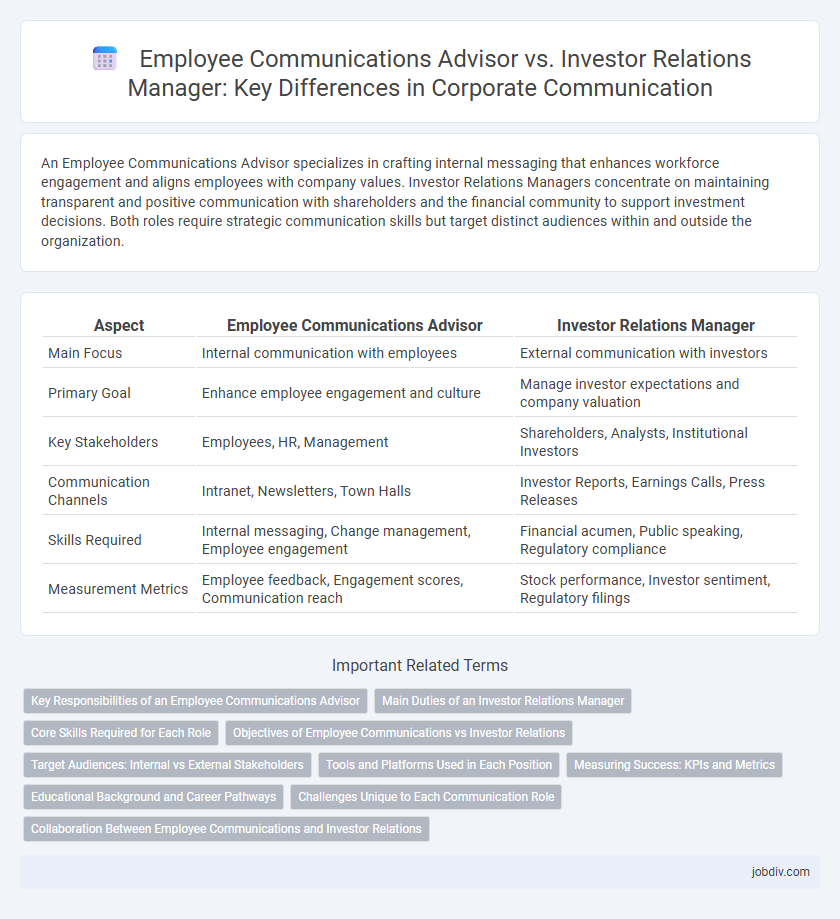An Employee Communications Advisor specializes in crafting internal messaging that enhances workforce engagement and aligns employees with company values. Investor Relations Managers concentrate on maintaining transparent and positive communication with shareholders and the financial community to support investment decisions. Both roles require strategic communication skills but target distinct audiences within and outside the organization.
Table of Comparison
| Aspect | Employee Communications Advisor | Investor Relations Manager |
|---|---|---|
| Main Focus | Internal communication with employees | External communication with investors |
| Primary Goal | Enhance employee engagement and culture | Manage investor expectations and company valuation |
| Key Stakeholders | Employees, HR, Management | Shareholders, Analysts, Institutional Investors |
| Communication Channels | Intranet, Newsletters, Town Halls | Investor Reports, Earnings Calls, Press Releases |
| Skills Required | Internal messaging, Change management, Employee engagement | Financial acumen, Public speaking, Regulatory compliance |
| Measurement Metrics | Employee feedback, Engagement scores, Communication reach | Stock performance, Investor sentiment, Regulatory filings |
Key Responsibilities of an Employee Communications Advisor
An Employee Communications Advisor focuses on crafting internal communication strategies that enhance employee engagement, promote organizational culture, and ensure clear dissemination of corporate policies and updates. Key responsibilities include developing targeted messaging, managing internal communication channels, and facilitating feedback mechanisms to improve workforce alignment with company goals. Their role directly supports organizational productivity by fostering transparent and effective communication between leadership and employees.
Main Duties of an Investor Relations Manager
An Investor Relations Manager primarily manages communication between a company's corporate management and its investors, ensuring accurate and timely financial disclosures, earnings reports, and compliance with regulatory requirements. They develop and execute strategies to maintain investor confidence, facilitate shareholder meetings, and prepare presentations for earnings calls and investor conferences. This role demands deep financial knowledge and strategic communication skills to align investor relations with overall corporate objectives.
Core Skills Required for Each Role
Employee Communications Advisors require expertise in internal communication strategies, change management, and employee engagement techniques to ensure clear messaging within an organization. Investor Relations Managers need strong financial acumen, strategic communication skills, and the ability to interpret market data to effectively communicate with shareholders and analysts. Both roles demand excellent interpersonal skills, but the former prioritizes internal audience focus while the latter centers on external stakeholder relations.
Objectives of Employee Communications vs Investor Relations
Employee Communications Advisors focus on fostering internal engagement, enhancing organizational culture, and ensuring transparent, consistent messaging to boost employee morale and productivity. Investor Relations Managers concentrate on maintaining investor confidence, delivering accurate financial information, and managing market perceptions to support company valuation and shareholder value. Both roles prioritize targeted communication strategies but differ in audience and key objectives related to internal alignment versus external financial trust.
Target Audiences: Internal vs External Stakeholders
Employee Communications Advisors specialize in crafting messages tailored to internal stakeholders such as employees and management, fostering engagement and alignment within the organization. Investor Relations Managers focus on external stakeholders including shareholders, analysts, and potential investors, ensuring transparent and strategic communication about financial performance and corporate strategy. Both roles require distinct approaches to content and channels to effectively address the unique needs and interests of their target audiences.
Tools and Platforms Used in Each Position
Employee Communications Advisors predominantly utilize internal communication platforms such as Microsoft Teams, Slack, and intranet portals to facilitate real-time collaboration and streamline message dissemination across departments. Investor Relations Managers rely heavily on financial disclosure tools like Bloomberg Terminal, Thomson Reuters Eikon, and specialized IR platforms such as Q4, enabling accurate investor targeting, shareholder engagement, and compliance with regulatory reporting requirements. Both roles integrate analytics software to measure communication effectiveness, but their toolsets diverge based on audience focus and content specificity.
Measuring Success: KPIs and Metrics
Employee Communications Advisors gauge success through internal engagement scores, employee feedback surveys, and message comprehension rates, ensuring alignment with organizational culture and values. Investor Relations Managers focus on stock price performance, shareholder sentiment, and earnings call feedback, emphasizing transparency and market confidence. Both roles utilize tailored KPIs to drive strategic communication effectiveness within their respective audiences.
Educational Background and Career Pathways
Employee Communications Advisors typically hold degrees in communications, public relations, or human resources, with career pathways often beginning in internal communications or corporate communications roles. Investor Relations Managers usually have educational backgrounds in finance, business administration, or economics, progressing through roles in investment analysis, financial communications, or corporate finance. Both positions require strong communication skills, but Employee Communications Advisors focus on internal stakeholder engagement while Investor Relations Managers specialize in external financial communications.
Challenges Unique to Each Communication Role
Employee Communications Advisors face the challenge of fostering internal engagement and aligning diverse workforce segments with corporate culture during organizational change. Investor Relations Managers must navigate regulatory compliance and effectively convey complex financial data to maintain investor trust and manage market expectations. Each role demands specialized communication strategies tailored to their distinct stakeholder groups and information sensitivity.
Collaboration Between Employee Communications and Investor Relations
Employee Communications Advisors and Investor Relations Managers collaborate to ensure consistent messaging across internal and external stakeholders, aligning company goals with investor expectations and employee engagement. They share insights on corporate developments, financial performance, and strategic initiatives to foster trust and transparency, enhancing overall corporate reputation. This collaboration streamlines communication flow, supports unified branding, and drives informed decision-making within the organization.
Employee Communications Advisor vs Investor Relations Manager Infographic

 jobdiv.com
jobdiv.com